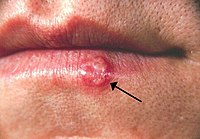
Photo from wikipedia
A 31-year-old man was admitted with acute respiratory distress, fatigue and persistent fever despite broad-spectrum antibiotics. A year previously he had presented with cutaneous and pulmonary Kaposi sarcoma and had… Click to show full abstract
A 31-year-old man was admitted with acute respiratory distress, fatigue and persistent fever despite broad-spectrum antibiotics. A year previously he had presented with cutaneous and pulmonary Kaposi sarcoma and had been found to have human immunodeficiency virus (HIV) infection. On this presentation, computed tomography scans of his chest and abdomen showed hepatosplenomegaly, retroperitoneal lymphadenopathy and a pleural effusion. The HIV viral load was high (7 72 log) and the CD4 T-cell count was 0 228 9 10/l. There was hypertriglyceridaemia (4 91 mmol/l) and hyperferritinaemia (3468 lg/l). No infective aetiology that could explain the clinical features was identified. A full blood count and differential showed haemoglobin concentration 77 g/l, platelet count 9 9 10/l and leucocytes 6 39 9 10/l with lymphopenia (0 89 9 10/l). Peripheral blood films showed large ‘activated’ cells with abundant basophilic cytoplasm with a cytoplasmic hof, and nuclei containing 1 to 2 prominent nucleoli (top). Bone marrow films also disclosed these abnormal cells as well as numerous haemophagocytic macrophages (bottom left). On flow cytometry, the lymphoid cells showed partial expression of CD19, strong expression of CD38, surface k light–chain restriction and absence of CD20, CD22 and CD138, consistent with the immunophenotype of plasmablasts (bottom right). A diagnosis of primary effusion lymphoma was considered but the pleural fluid contained only macrophages and the lymphoma cells were CD138 negative. Several days later a lymph node biopsy was performed, disclosing clear features of Castleman disease. On immunochemistry, the atypical cells were positive for human herpes virus 8 (HHV8), previously known as Kaposi-sarcoma-associated herpesvirus, leading to a final diagnosis of large B-cell lymphoma arising in HHV8-related multicentric Castleman disease. The HHV8 viral load was high. Hepatic biopsy confirmed haemophagocytic lymphohistiocytosis. Immunophenotyping was critical in this case to characterize the abnormal cells and establish a definitive diagnosis.
Journal Title: British Journal of Haematology
Year Published: 2018
Link to full text (if available)
Share on Social Media: Sign Up to like & get
recommendations!